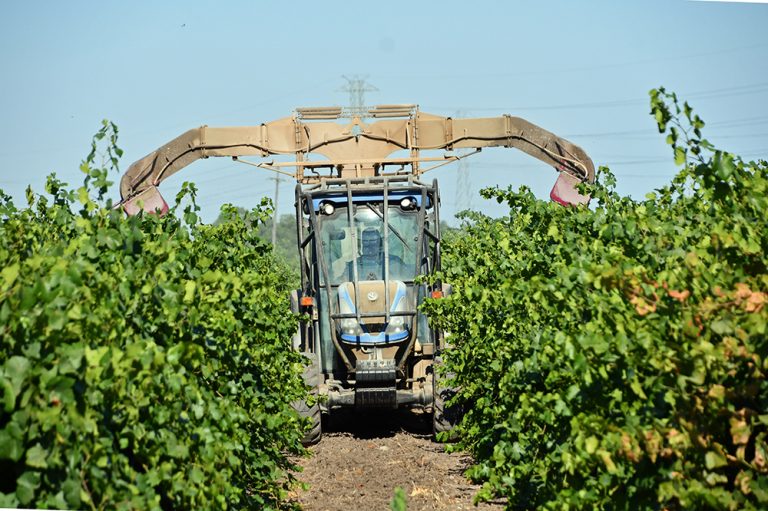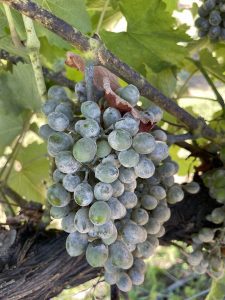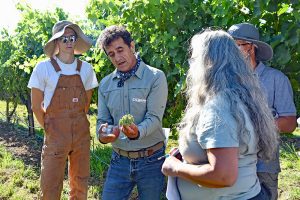
Although unusually cool, wet weather kept powdery mildew at bay during the early part of this season, more moderate weather in late spring created a near-ideal environment for the fungus. This allowed UCCE Plant Pathologist Akif Eskalen to put 65 fungicides, alone or as part of season-long programs, to the test under tough powdery mildew conditions at a UC Davis vineyard.
But Eskalen viewed fungicides as just part of an integrated approach that should also include using the Gubler-Thomas Powdery Mildew Index to gauge disease risk and modifying the vineyard environment through practices such as leaf removal. He also encouraged growers and PCAs to do their homework and keep an open mind.
Pete Sweeney, a PCA for Grow West in Geyserville, Calif., does just that. Each year, he said he studies the powdery mildew trial results, first when Doug Gubler conducted them and now Gubler’s successor, Eskalen.
“I really like what those guys do,” Sweeney said.
Eskalen said conducting fungicide trials annually is important as new products are introduced to the market. Having up-to-date results also helps growers.
“If you‘re just staying with what you used 10 years or 20 years ago, you’re not keeping up; you’re behind the game,” he said.
Annual Powdery Mildew Trials Continue
Eskalen took over the program in 2018, replacing Gubler who had conducted fungicide efficacy trials for about three decades.
This year’s powdery mildew trial was conducted in a 12-year-old vineyard with chenin blanc, a susceptible variety, on the UC Davis south campus. Trial entries included synthetic, organic and biological fungicides. The crew used a backpack sprayer to apply materials on frequencies ranging from 7- to 21-day intervals.
Each treatment was replicated five times, after which 25 fruit clusters were evaluated for disease severity in late July.
In this year’s trials, the organic and biological products did not perform as well statistically as synthetic compounds. But Eskalen said it was important for growers and PCAs to incorporate more non-traditional products into programs to reduce the risk of fungicide resistance from developing.
Resistance management involves rotating effective modes of action based on Fungicide Resistance Action Committee (FRAC) codes. Applying the same materials repeatedly without rotating allows for resistance development. Those pathogens not controlled by the material reproduce, eventually outnumbering susceptible organisms.
Already, powdery mildew has confirmed resistance to the strobilurin group of fungicides, also known as QoIs.
Eskalen also pointed to the state’s “Sustainable Pest Management: A Roadmap for California” released earlier this year as a reason why he included softer materials. The program from the California Department of Pesticide Registration seeks to identify what it considers “priority pesticides” for replacement or eventual elimination by 2050. The state defines priority pesticides as high-risk products, active ingredients or groups of related products considered hazardous and that pose “potentially severe or widespread adverse impacts.”
Sweeney said he has noticed the inclusion of more organic and biological compounds in the trials over the years. He also has had discussions with Eskalen about the products’ efficacy.
“If you actually talk to [Eskalen], which I have done several times, conventional products work great,” he said. “Organic products don’t come out better if you get into it and actually read the research.”
Sweeney said he also likes to take a season-long program approach to powdery mildew management, rotating products with different FRAC codes. His goal is to develop plans for his growers that have the least risk of powdery mildew development.
The Disease Triangle
Powdery mildew caused by Erysiphe necator is a polycyclic disease with multiple generations during the growing season. As such, growers may have to spray weekly or biweekly under ideal conditions to keep the disease at bay. The actual interval depends on the fungicide, weather conditions and label recommendations.
For any disease to develop, it needs a suitable host, a favorable environment and a viable pathogen.
Ideal conditions for powdery mildew in grapes include prolonged leaf moisture and temperatures between 70 and 85 degrees F. Leaf wetness and suitable temperature are the key, and rainy weather is not conducive to disease development, Eskalen said.
Cooler weather in 2023 delayed bud break and the beginning of fungicide applications by a few weeks compared to 2022. But as the weather began to warm this spring, powdery mildew took off.
“This year, in 2023, we had the perfect conditions for disease pressure,” Eskalen said. In the untreated controls in his trial, they saw 100% disease incidence, whereas in some other years, disease incidence was only 40%.

And it’s not just ambient air temperatures but also conditions within the grapevine canopy that influence disease development.
Once temperatures move into the 90s, Eskalen said powdery mildew reproduction slows and will stop once the mercury tops 95 degrees F.
The environment within a vineyard also contributes, he said. This year’s near-record rainfall promoted tall weeds in many blocks, reducing airflow, increasing humidity and enhancing powdery mildew conditions.
In addition, variety susceptibility plays a role, with carignane, Thompson seedless, ruby seedless, cardinal, chardonnay, cabernet sauvignon and chenin blanc being some of the most susceptible.
Sweeney described this year’s powdery mildew season in the North Coast where he works as returning to normal, noting the past two years have been very light.
George Zhuang, a UCCE viticulture farm advisor for Fresno County, said table grape, winegrape and raisin grape growers in his area this season experienced more severe powdery mildew pressure than in the northern San Joaquin Valley or North Coast. He blamed it partly on increased precipitation, which promoted larger canopies that increased in-vineyard humidity and created near-ideal disease conditions.

The late bud break also caught some growers by surprise, Zhuang said.
“I think a lot of growers still use the calendar for spray programs and to schedule their sprays,” he said. “When we started the season, it was unusually cold, and it slowed canopy growth and slowed pathogen development.”
Typically, growers in his area begin fungicide applications about mid-April shortly after bud break. This year, they started in late April or early May, and even then powdery mildew pressure was low. In early June, temperatures warmed, and the pathogen took off.
“There was a huge explosion of powdery mildew pressure at the beginning of June, and it kind of surprised everybody in terms of how to time their spray intervals,” Zhuang said.
He pointed to the importance of the Gubler-Thomas Powdery Mildew Risk Index when timing fungicide applications.
Don’t Guess, Use the Index
Developed by Gubler and colleague Carla Thomas, the index draws data from weather stations and canopy leaf wetness sensors to determine the risk of powdery mildew developing. The model then calculates a daily risk index ranging from 0 to 100.
A reading of more than 60, for example, indicates a high risk. Growers and PCAS should shorten spray intervals to 14 days or the label minimum for chemical fungicides or seven days for sulfur, according to UC IPM guidelines. A reading of 0 to 30, on the other hand, means a low risk.
Chemical fungicide intervals may be stretched to 21 days or the label maximum, while sulfur may be used at 14- to 21-day intervals.
Eskalen said the index helps growers and PCAs make more informed decisions about fungicide applications and spray intervals.
“If we know about the conditions, we don’t have to spray based on the calendar,” he said. “That’s the risk index. If the risk is low, you don’t have to apply fungicides on a weekly basis. If the risk is high, you have to apply.”
Nearly 30 years after it was developed, Zhuang said, the index remains relevant, especially during a season like 2023.
“It’s still very important to track the powdery mildew index,” he said. “If you look at the powdery mildew index, in Fresno, we have eight weather stations across the county. You can see a very clear line that in May, the disease pressure was relatively low. But if you look after Memorial Day, everything just skyrocketed to the top of almost 100 for the entire month [of June].”
To view the results from this year’s powdery mildew trials as well as from several previous years, visit ucanr.edu/sites/eskalenlab/Fruit_Crop_Fungicide_Trials/. The site also provides links to trials that involve other fungal diseases and other tree fruit crops.











